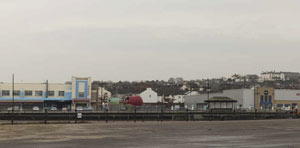articles/Cameras/DxO-One-page1
How to Jazz up an Apple? Add a DxO One! - part 1 of 1 2 3
by Mike McNamee Published 01/02/2016

Every now and again something crops up in the world of
technology that causes a stir and wakes journalists from their
slumbers. These are the gizmos that we talk about in the
office, show around, take to the pub to show our mates! The
DxO ticked all of these boxes!
The iPhone has a really nice screen but Apple have spent a fortune
making the phone thinner and thinner. This is a technical
problem because the back focal length, the distance behind
the lens, is correspondingly tiny and getting smaller. Thus the
light has to bend through incredible angles to reach the
sensor. The focal lengths of the lenses are proportionately
tiny (approximately 4mm) and the sensor sizes are
typically between 1/4 and 1/3 of an inch (6 to 8mm).
Despite these technical hurdles, the modern phone
camera has proved to be popular, almost ubiquitous -
just look at a wedding scene to see a forest of phones
held high over the users' heads and thus wrecking the
pro's shots coming in the other direction. The quality
of phone images is poor but this does not prevent
them from being distributed via phones and hungrily
downloaded. By definition, the punter's wedding shots
hit Facebook ahead of the official images. Despite the
remarkable engineering, the camera phone is close to its
limit, the pixels are now approaching significant portions of
the wavelength of light and no more can be cheated from
the physics!*
*Apple spend between $7 and $13 for both the front- and
back-facing cameras. For the iPhone 5S the costs are as
follows:
Total manufacturing cost $199
Display $41
Cameras $13
Wireless facility $32

Although it was an extremely dull day this near full- width shot reveals plenty of detail in the housing.
This then is the arena into which the DxO has burst. In essence it takes
the screen, the iPhone's interface and computing power and then bolts
on a device which overcomes the short-length-optics issues and all its
constraints. The DxO can accommodate a 1-inch sensor - that's nine times
larger than an iPhone. It is also 50mm front to back which is about seven
times more than an iPhone. This enables the DxO to pack 5,540 x 3,688
pixels creating a 40mb+ file in Photoshop which translates to an 18x12-
inch print at 300ppi. These pixels are illuminated by more conventional
optics without too many light-bending tricks being employed - even so,
the smart phone tricks to enhance ISO sensitivity have been added to the
DxO*.
* CMOS BSI - This is the camera technology taken from the iPhone. BSI Back
Side Illumination puts the photo diode detector right underneath the microchip
lens rather than below the interconnection wiring and thereby squeezes
a bit more sensitivity
You are currently on page 1
- How to Jazz up an Apple? Add a DxO One! page 1
- How to Jazz up an Apple? Add a DxO One! page 2
- How to Jazz up an Apple? Add a DxO One! page 3
1st Published 01/02/2016
last update 21/07/2022 08:49:43
More Cameras Articles
The Society of Photographers Convention and Trade Show at The Novotel London West, Hammersmith ...
You have 17 days until The Society of Photographers Convention Wednesday 14th January 2026




